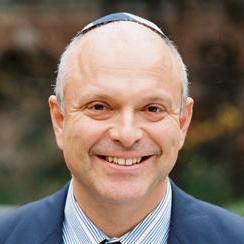Bringing God into Our Classrooms and Communities

I encouraged my third graders to sketch out what they were reading. They approached Benny, the art teacher, and asked whether they could build an elaborate golden table, as described in Exodus 25:23–30. He liked the idea. Three months later, right before Kabbalat Shabbat, Heschel-style—that is, before lunch on Friday—the constructed table left the art room and entered our third-grade classroom.
Nearly a third of the entire book of Exodus is dedicated to the design and construction of the Mishkan, a traveling sanctuary. Although this week’s parashah focuses mostly on architectural plans, there is significant, inspiring Torah about community building and even classroom dynamics. We read about a big idea; God wants to reenvision God’s place in the world. God believed that although the mountaintop was dramatic and awe-inspiring, the theophany at Sinai required the people to stop their desert trek. Indeed, if God were to be a constant presence in the hearts and minds of the wandering Israelites, God would have to adapt and descend the mountain to “dwell among the people” (Exod. 25:8). So, God decided to build a Mishkan, the Tabernacle, and asked every Israelite who felt inspired to bring a terumah (gift/offering) and create together a sacred space for both God and community.
Kabbalat Shabbat wasn’t working in my classroom. It was the end of the week. On Fridays dismissal was early, and we all rushed through the blessings to get to lunch. God wasn’t leaping off the page as we chanted kiddush, the blessing over wine. As much as I tried to encourage my students to join me in song, there was too much quiet in the room. God seemed absent. We needed to engage differently. We had to find a way to reenvision our sacred time, and reading Parashat Terumah helped guide us.
God’s command to Moses to create the Mishkan is unusual. God asked for gifts from every person whose heart moves him [or her] (Exod. 25:2). God believed that the Children of Israel should not be coerced to give, and understood that if God’s mission were compelling enough, the community would respond willingly. It’s interesting that voluntary giving has not been the model most synagogues have adopted in North America. Only now, based on shrinking numbers in our synagogues, is Jewish leadership questioning whether a pay-for-service model (i.e., dues) should continue. Service may be less about being given something and more about being called upon to give voluntarily. Practically, a “terumah approach” demands that communities have mission statements with clear rationales in order to attract members who have an affinity to the core values articulated by a particular community. And once the right match is made between the individual and the community, volunteer engagement has been shown to increase.
The golden table was their project. It wasn’t assigned to them. It hadn’t been part of Benny the art teacher’s original curriculum for the third-grade class. But Benny loved the idea because the kids were so excited. The class agreed upon a final design together with their teacher. Construction began immediately. Everyone selected a task: we had woodcutters, sanders, and dowel makers. A few students installed the hardware, the rings for the dowels that were attached to the table. The students wanted the table to be used in our Friday Kabbalat Shabbat ritual of welcoming the Shabbat into our midst. The table was in a very real sense a commission, dedicated to God and community.
A feature of the Hebrew language is that its words have multiple and associative meanings. The word terumah, translated sometimes as “gifts,” means “raising up,” as well. However, one should not conclude that the act of giving elevates a person in terms of social status—rather that it elevates a person to a higher calling as the person engages in communal endeavors where God dwells. This sense of purpose can increase one’s capacity to contribute by doing even more.
The shulhan hazahav (the golden table) was ceremoniously brought into the classroom. Four students, one at each end, lifted the dowels and set them on their shoulders and beamed with pride. Challot for Kabbalat Shabbat were placed on it. Every Friday for the remainder of the year, a different group would bring the golden table into the classroom. We sang wordless Shabbat melodies (niggunim) and recited kiddush and hamotzi with greater intensity than before. We raised the volume because we were involved. We had purpose. We found meaning. Our voices could be heard in the hallways. God had entered our classroom, and my community of learners in K-504 were joyful.
In light of this week’s parashah, may I suggest that we think about whether our synagogues’, schools’, and work settings’ mission statements are relevant to the needs of the people they serve? Have the institutions we serve had to revise their mission statements recently? Do we volunteer in ways that employ our expertise and interests? How do the organizations we support raise us up and make us better human beings? My hunch is there’s plenty of work to be done. But perhaps the third graders I was fortunate enough to teach can remind us that success in building golden tables—that is, engaging in a collaborative effort with purpose—can transform communities and classrooms where God dwells.
The publication and distribution of the JTS Torah Commentary are made possible by a generous grant from Rita Dee and Harold (z”l) Hassenfeld.



